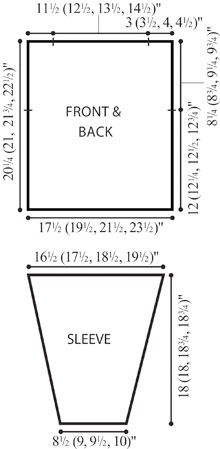 Toward the end of every sweater pattern there are line drawings, with bullets and numbers skirting the sides and words like “Back” and “Left Front” scrawled across the centers. These are called schematics, and they have some important uses in the world of sweater making.
Toward the end of every sweater pattern there are line drawings, with bullets and numbers skirting the sides and words like “Back” and “Left Front” scrawled across the centers. These are called schematics, and they have some important uses in the world of sweater making.
First and foremost, schematics, which are drawn to scale, give you an at-a-glance rundown of all the measurements, angles and shapes of the sweater you’re about to make. They tell you if the sweater tapers at the waist or narrows at the shoulders, as well as indicating the exact depth and width of the armholes, bust and sleeves. The most exciting part about schematics is that they give you a mini-representation of what your sweater pieces will look like when you’ve finished knitting them.
In general, the simpler the sweater, the simpler the schematic. The basic drawings to the right are good examples of schematics for a beginner-level woman’s pullover sweater. The numbers outside the parentheses represent the smallest size, while the numbers inside the parentheses indicate measurements for sequentially increasing sizes.
The schematics for a cardigan are much like those for a pullover sweater, but with one main difference: the fronts. In general, one of the two fronts will be drawn, and then you just have to imagine (or sketch) a mirror image for the other.
